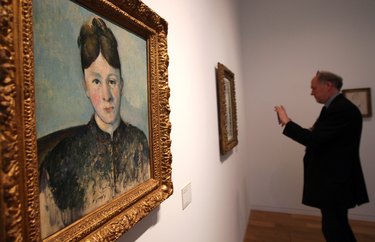
The French painter Paul Cezanne was a unique figure among artists of the 19th century. Like his peers, known as the Impressionists, Cezanne dedicated much of his work to re-creating the effects of light and shadow on canvas. But larger themes of internal struggle and spiritual urgency also dominate his paintings, leading him to proclaim: "I can't seem to express the intensity which beats in upon my senses." Cezanne's rare combination of classical sensibility and abstract yearning drove him to employ several unconventional painting techniques.
The Unprimed Canvas
Video of the Day
Like his hero Gustave Courbet, Cezanne preferred to paint using coarse, unprimed canvases to impart a dramatic tension to his work. Using a palette knife, Cezanne applied his paint in thick, blocky patches that would then form cracks on the rough surface of the unfinished canvas. Viewers can see the results of this raw painting style in Cezanne's early portraits, particularly the 1866 painting "Antoine Dominique Sauveur Aubert (born 1817)," which shows an underlying network of cracks on the subject's face and clothing.
Video of the Day
Cezanne’s Layering Method
One of the most distinct qualities of Cezanne's early work is evident in his application of thick layers of pigment to provide dramatic contrasts. This allowed him to preserve in visual form the vigorous strokes he used to imbue his subjects with life and -- in a radical way -- blend his artistic process with the painting's subject. An example of this early style is the 1866 painting "Louis-Auguste Cezanne, the Artist's father, Reading 'L'Evenement.'" In the late 1870s, Cezanne began to experiment with smoother tonal variations, abandoning his thick, dark painting method in favor of a technique using gradual changes in color to denote contrasts between light and shadow. One of the best examples of this more polished style is his 1890 painting "Still Life with Apples and a Pot of Primroses."
Creating Form through Color
As his style continued to progress, Cezanne began incorporating new techniques for depicting the three-dimensionality of his subjects. The most striking of these techniques was his use of color gradations to generate a sense of form and distance in the people and objects in his work. By surrounding a lighter colored pigment with slightly darker, similar colors, Cezanne was able to re-create a sense of tangible weight and form. Perhaps the best example of this technique of figure composition appears in his 1890-1892 painting "The Card Players," which depicts a scene of four men smoking and playing cards. The slight color gradation on the hands and faces of the players -- as well as on their clothing and pipes -- creates a feeling of depth and proportion not seen in his earlier work.
Painting Outdoors
Like his Impressionist peers Auguste Renoir and Claude Monet, Cezanne eventually took his work outdoors in an attempt to capture the movement of light and shadow in real time. This involved the use of thick, short brushstrokes intended to portray the fleeting essence of a moment rather than focus on its details. Significant in Cezanne's landscapes was the use of indistinct daubs of paint in order to suggest rocks, trees and other elements of the landscape. This resulted in unconventional landscapes composed of more abstract elements, such as the 1905 painting "Mont Sainte-Victoire."
- Smithsonian Magazine: Cezanne: The Man Who Changed the Landscape of Art
- The Metropolitan Museum of Art: Paul Cezanne (1839-1906)
- The Metropolitan Museum of Art: Antoine Dominique Sauveur Aubert (born 1817)
- The Metropolitan Museum of Art: Still Life with Apples and a Pot of Primroses
- The Metropolitan Museum of Art: The Card Players
- Artble.com: Paul Cezanne
- TheArtStory.org: Louis-Auguste Cézanne, the Artist's father, Reading "L'Evenement"
- Impressionism.org: En Plein Air